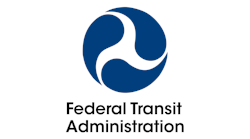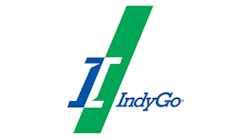FTA awards $149.9 million CIG grant for IndyGo’s Blue Line BRT project
The Federal Transit Administration (FTA) has awarded a $149.9 million grant through the Capital Investment Grants (CIG) program to the Indianapolis Public Transportation Corporation (IndyGo) to help fund construction of the Blue Line Bus Rapid Transit (BRT) project in Central Indiana. The 24-mile BRT line will connect the Indianapolis International Airport to the town of Cumberland via downtown Indianapolis along I-70, Holt Road and Washington Street.
The funding from FTA’s CIG program represents nearly 40 percent of the project’s budget. The remaining project costs are being covered by a combination of local funding from the transit income tax authorized by the City-County Council and Indianapolis Mayor Joe Hogsett, as well as the Indianapolis Department of Public Works, the Indianapolis Metropolitan Planning Organization, Citizens Energy Group and other federal sources, including $1 million in community project funding secured by State Rep. André Carson (D-7) and nearly $22 million from the Rebuilding American Infrastructure with Sustainability and Equity grant program.
The FTA Small Starts grant funding is the latest milestone in the Blue Line project and follows the recent award of construction contracts to three Central Indiana contractors in Gradex Inc., F.A. Wilhelm Construction Co. and R.L. Turner Co.
"With enhanced reliability, greater frequency and comfort, this expansion guarantees that every resident and visitor has access to vital hubs in Indianapolis, which is particularly gratifying to see in my home state," said U.S. Department of Transportation Secretary Pete Buttigieg. "The Biden-Harris Administration is enhancing the way people travel in the country’s heartland by connecting riders to the airport, students to education and Indy residents to new opportunities while supporting economic vitality and regional growth."
“This is the third and final planned BRT route, which collectively with the Red and Purple lines, will serve as the backbone for our entire transit system,” said IndyGo President and CEO Jennifer Pyrz. “Receiving these funds from the federal government for the Blue Line is proof that transit is essential in Indianapolis and worthy of high-level investment. We’re grateful to the FTA for putting their trust in us to deliver on this critical project and look forward to the positive impact this investment will have on the Central Indiana economy.”
The project includes 12 miles of dedicated bus-only lanes in the urban core, helping speed riders on their way. FTA notes the corridor encompasses some of the region's largest trip generators, including downtown Indianapolis, the State Capitol, the airport and the Indianapolis Zoo. The Blue Line will also stop at three high schools and several planned redevelopment areas.
"This investment in the Blue Line represents a real commitment to the city's transportation infrastructure and will reduce transit travel times in the corridor by up to 30 percent," said FTA Deputy Administrator Veronica Vanterpool. "With upgraded traffic signals, miles of resurfaced lanes, new and replaced sidewalks, curb ramps, bike stations and crosswalks, FTA is building safer, more sustainable, and accessible pathways for everyone, including improved transit service for a large number of low-income and zero-car households."
The project includes 60-foot hybrid buses, helping improve air quality. With more than 45,000 people within walking distance of a station in the corridor, IndyGo notes service will operate 20 hours per weekday, with frequent service. The 30 stations will offer a variety of transit choices, including access for pedestrians, cyclists, transfers to and from other routes and park-and-ride commuters.
Beyond transit, IndyGo notes much of the significant infrastructure improvements will go toward constructing critical safety improvements along the Washington Street corridor, including new traffic signals, new or upgraded sidewalks and pedestrian crossings, as well as new or upgraded curb ramps to meet ADA standards.
According to the agency, transit riders will also benefit from the many BRT features, including more frequent and efficient service, level boarding, enhanced stations with real-time signage, off-board fare collection through MyKey and covered platforms for weather protection.
IndyGo will share the latest information regarding the anticipated construction schedule, planned detours and other relevant information during a series of public open houses taking place along the Blue Line corridor in February. Construction is expected to begin in early 2025, with the route set to open for service in late 2028.

Brandon Lewis | Associate Editor
Brandon Lewis is a recent graduate of Kent State University with a bachelor’s degree in journalism. Lewis is a former freelance editorial assistant at Vehicle Service Pros in Endeavor Business Media’s Vehicle Repair Group. Lewis brings his knowledge of web managing, copyediting and SEO practices to Mass Transit Magazine as an associate editor. He is also a co-host of the Infrastructure Technology Podcast.




